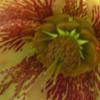
Ginkaku-ji (The Silver Pavilion) was our first Japanese garden of the tour and delivered on many of the archetypal Japanese garden elements. I’ve already shown you the Golden Pavilion, the garden of Yoshimitsu, and the Silver Pavilion is the garden of his grandson, Yoshimasa (1435-1490).

Ginkaku-ji is home to some early examples of the dry landscape gardens of the late Muromachi era; these symbolise the ocean and the mountain. The ocean (above) is represented by ginshanada which means ‘silver sand open sea’ and you can see that the sand is raked to represent the waves. I am curious as to how often the sand has to be raked. Having peered at it and other sand gardens we saw it seems that the sand must be combined with something to keep it in shape, otherwise surely when it rains the patterns would be destroyed. You can just about see how sharp the edges of the sand platform are and to my simple mind the sand must have been treated in some way to keep this looking good.

Again, looking at the second element of the sand garden – the mountain, kogestsudai, a ‘platform facing the moon’, you can see how precise the shape is especially the flat top. The dry sand elements are based on zen principles and are intended for contemplation.

I have to admit to being left rather cold by the sand gardens we saw, particularly as they are so antiseptic in appearance encouraging no wildlife whatsoever.

I much preferred the garden away from the dry sand garden. Near the Silver Pavilion you have a strolling garden which is a variation of the gardens, exemplified by the Golden Pavilion and would probably have originally been intended to be viewed from boats on the lake or from within the temples. The current garden is much diminished in size from Yoshimasa’s time having only two buildings left of the original twelve.

Having done some research since my return this waterfall could well be the ‘sengestsu-sen’ waterfall which means ‘spring in which the moon washes’ and apparently it is intended to capture the reflection of the moon ‘washing’ itself in the waters. I much prefer the greenness of this part of the garden over the gray of the dry sand.

From the lower part of the garden you traverse steep paths up the slopes to the upper garden from where you have wonderful views out over Kyoto. The upper garden is a moss garden with streams, islands and bridges. The path then brings you back past the Silver Pavilion.

The Silver Pavilion is a bit of an enigma as there are no silver elements so no rationale for it name. As Ginkaku-ji was not finished before Yoshimasa’s death in 1490 then I suppose its possible that there was an intention to finish the Pavilion along the lines of the Golden Pavilion, other theories are that the name was coined to distinguish it the two Pavilions or alternatively because the moon’s light was reflected off the building’s former dark timber.
The pavilion you see in these photos was reconstructed in 2010; we soon learnt during our travels that few of the buildings we saw were original. Hardly surprising given the construction is based on timber, prone to fires and earthquake damage.

For me the nicest part of the garden was up in the high garden amongst the trees, which were slowly changing color for the Autumn, and looking out across Kyoto.

Whilst I was bowled over by the splendour of the Golden Pavilion, I preferred the quieter gentleness of the Silver Pavilion garden.

